Think about your future forest
Michelle Harnett, New Zealand Tree Grower February 2021.
It is the year 2050 and you are about to the harvest unpruned radiata pine you grew at 600 stems a hectare. Has everything gone to plan? How different would things be if you had applied the latest in forestry research at the time of planting?
The Resilient Forests research programme is focussed on growing healthy trees with desirable wood qualities using good planning and forest management to cope with risk and uncertainty. The programme builds on the work of the Growing Confidence in Forestry’s Future and a portion of the Healthy Trees Healthy Future programme.
The programme aims ensure the long-term economic, environmental and social sustainability of forestry. Part of this is making sure New Zealand’s forests are more resilient to future uncertainties, including changing markets and prices, new pathogens and pests, climate change and social acceptability. Ideally, the results will give forest owners and managers what they need to account for future risk and uncertainty, and to come up with plans to maximise long-term returns.
Results are already being translated into forest management recommendations which can be used by owners of small to medium size forests. Now is the time to find out how you grow your best crop ever for harvest in 2050.
Planning for productivity
Forest owners and managers are increasingly able to use remote sensing data to identify which aspects of genetics, forest management and environmental variables such as climate and soil type have the greatest influence on productivity in their forests. In one central North Island forest, remote sensing data was able to predict yield with more than 90 per cent accuracy. The main productivity factors in this case were stems per hectare, soil type and genetics. Elevation above sea level and winter sun were also important environmental factors.
Planting also involves trying to account for the inevitable risk and uncertainty which a 28-year rotation brings. With climate change likely to affect growth, along with price fluctuations, one possibility is to build up a forestry portfolio to help account for the unknowns while ensuring you get the best yield and return.

Build a forestry portfolio
A forestry portfolio can be developed using the same method that you would use to build stock portfolio – by investing in higher or lower risk shares with different returns over time and aiming for the lowest possible risk for either a low or high return. Scion economists have modelled the effect of building different forest regime portfolios.
Future climate change models have been used to predict how a forest near Rangiora might grow from slightly warmer conditions with a temperature increase of 2°C to much warmer at 5°C under different climate scenarios. In addition, future changes in log prices for pruned and unpruned radiata pine grown at final stocking rates of 300 and 600 stems a hectare have also been estimated. Then the annualised timber returns for high, average and low forest productivity under high, average or low prices were calculated.
This work suggests that a grower who wants to minimise market and climate change risks should consider a portfolio of unpruned trees at 600 stems a hectare and 300 stems a hectare, as well as pruned trees at 300 stems a hectare. However, a grower might be better off with higher proportions of pruned trees at 300 stems a hectare if the objective is to achieve higher timber returns.
Note that this example was based on a forest near Rangiora in Canterbury where the climate is likely to become hotter and dryer. A similar exercise for another region is quite likely to produce different results. Site conditions which affect productivity also affect the recommended stocking rates.
Seedlings and site preparation
Selecting the best growing stock is important. New research is showing that choosing the right trees for your place may entail more than opting for latest genetically-improved seedlings. Results from trials suggest that some clones do better at some sites and poorly at others.
Six sites of the accelerator trial series were established throughout New Zealand from 2016 to explore the limits of sustainable site productivity. Where possible, the same clones were planted at different sites. As the first results from the trials are becoming available, they show that fast growing clones, as measured by increase in diameter at breast height, do well at sites as diverse as southern Kaingaroa and Rangipo. However, other clones are struggling at poorer sites. In contrast, a hybrid cross of radiata pine and Pinus attenuata is doing well at Ashley and Tairua, but not at Rangipo, or southern and central Kaingaroa.
Clearly, some clones are well adapted to particular sites and others are overall consistently strong performers. Exploring the genetic and environmental factors or genotype which influence productivity and how to use this knowledge is a focus of current research. Results from the accelerator trials also offer some guidelines for ground preparation.
The effects of ripping – essentially ploughing to loosen the soil to prepare for planting − have been investigated at the fertile Rangipo site. Four years after planting, trees planted in un-ripped ground have significantly greater diameter at breast height as well as higher levels of nitrogen and phosphorus in their foliage. Seedlings planted at a higher density of stems per hectare also have a greater diameter at breast height after three years.
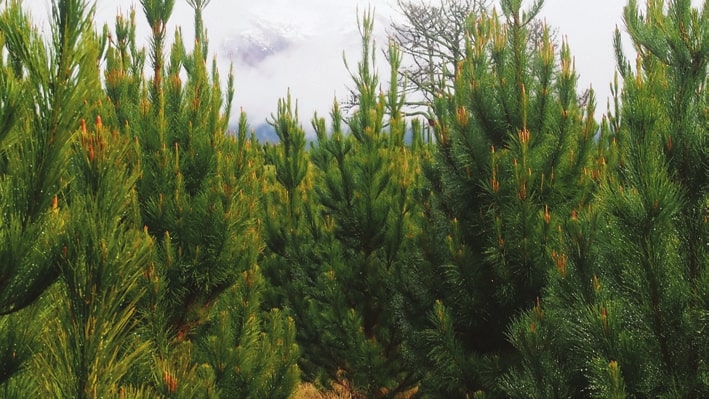
Pampered pines
Once in the ground, seedlings tend to be left to fend for themselves, apart perhaps from pruning and thinning. However, it is possible to take steps to increase health and productivity, and mitigate losses from pests and diseases.
Remoting sensing is being used to keep an eye on forest health and productivity using data from laser scanners and cameras mounted on drones, other aircraft and satellites. Hyperspectral imagery, which records the wavelengths of light reflected by vegetation, is looking especially promising for picking up signs of nutritional deficiencies, water stress and disease. Depending on results and resources, forest owners and managers can take action, for example, adding fertiliser to correct a nutritional deficiency and boost growth to improve forest nutrition.
Forest nutrition
Radiata pine plantations rarely have fertiliser added unless the local soil is known to be deficient in specific nutrients. In general, extra nitrogen would support more growth but results from nitrogen application trials carried out over the years have been inconclusive, with positive and negative effects reported. This of course, is annoying to forest scientists, who have been working to understand what is happening by looking at variables such as site-specific requirements, the form of nitrogen added and when it is applied.
Sometimes it is hard to for plants to extract nitrogen from the soil. Nitrogen is present naturally in two stable forms, or isotopes, the majority in a light form and a very small amount in a heavy form. A nitrogen enrichment factor can be calculated by looking at the ratio of the two. The more negative this number is, the harder it is for plants to take up nitrogen from the soil.
Work looking at the nitrogen enrichment factor and other environmental and management variables has found that tree age and enrichment factor are the two most important variables associated with tree growth. Targeting young trees between three and 15 years, and sites where nitrogen is harder for plants to access is likely to give the best growth responses.
Beyond simply applying nitrogen, ensuring site-specific nutrient requirements has an even greater effect. For example, site-specific nutrient treatments have been applied to nine mid-rotation radiata pine field trials from Northland to Otago. Three years after applying the fertiliser, an average volume gain of 2.2 per cent a year has been seen. Applying nitrogen alone resulted in smaller volume gains. Over a full rotation of around 30 years, the potential for significant volume gains highlights the importance of considering which other nutrients could promote growth.
Fertiliser could be considered an extra input to our forests at a time when there is growing awareness of the need to reduce chemical usage as a part of forestry’s social licence to operate. However, it must be noted that forestry uses less than one per cent of the fertiliser applied in New Zealand. The potential for nitrogen to leach into the environment is also a concern, therefore Scion and some large forestry companies are looking at the effects of nitrogen application on leaching and sustainability.
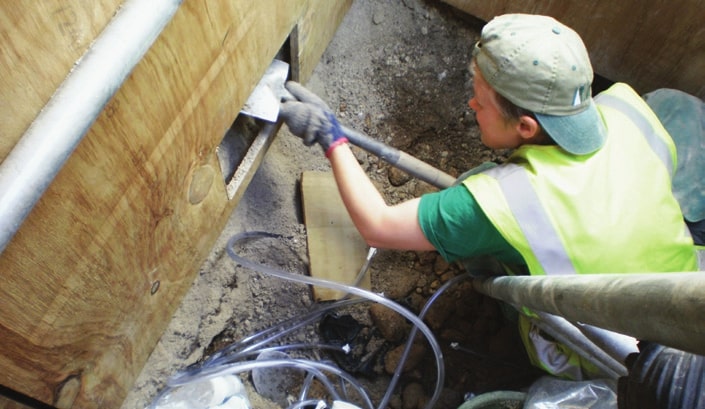
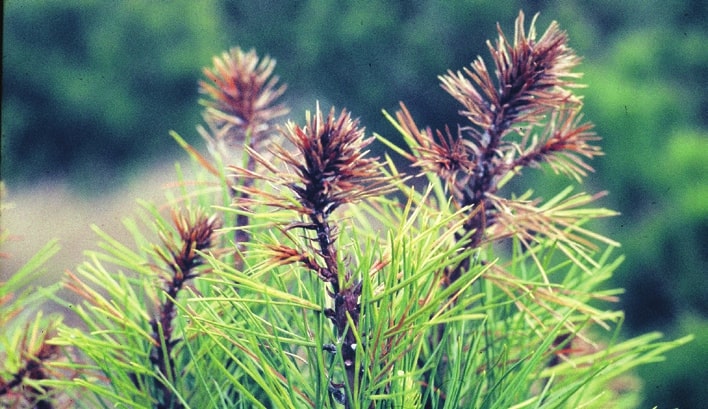
The potential of micronutrients
Nitrogen is a nutrient required in large amounts, and termed a macro-nutrient. Elements such as boron, which are essential in small to tiny amounts, are micronutrients. Micronutrients are important components which regulate metabolism and growth at a cellular level. Micronutrients are also critically important for soil microbes, biodiversity and the forest ecosystem as a whole.
Researchers are exploring the potential of specific micronutrients to boost forest productivity, sustainability, and resilience. Results suggest that optimising the availability of specific micronutrients could improve plant water use efficiency, growth and development, and enhance tolerance to drought and disease.
Planning is underway to look at some of the effects of boron, molybdenum, manganese and zinc. The initial focus is on how these interact with the plant microbiome to regulate processes and ecosystem functions. This will be followed by investigating how seedlings grown under stress benefit from selected micronutrients, before field trials in spring 2021.
Measuring nutrients
Forest owners and managers need to be able to get information on what is in their soil quickly, cheaply and reliably before they can start to optimise forest nutrition to and support long-term sustainable productivity. Recognising this, scientists are developing two complementary analytical methods.
The first method is based on mid-infrared spectroscopy of soil and foliage samples. This is a lab-based method and is a quick and cost-effective way to detect and quantify many different properties with one scan, including major minerals and soil pH. Each element absorbs and reflects infrared light at a characteristic wavelength.
The second method showing promise is remote sensing of hyperspectral data from trees. Photosynthesis is affected by nitrogen and phosphorus levels. Preliminary work using small radiata pine in pots has shown hyperspectral data can predict when nitrogen and phosphorus levels are limiting growth. This work is being scaled up to collect data from already established field trials.
The potential of the microbiome
Forest nutrition affects the entire forest ecosystem, including the microbes which live in, around and on trees and plants − the plant microbiome. The intimate association of a plant and its microbiome means this can influence nutrition, response to stresses such as drought, pathogens and pests and therefore productivity and growth.
The new Tree Microbiome Project will be looking at which organisms are present, how they affect trees and the potential for using the microbiome to alter tree phenotypes or even apply new traits via microbial association. This could be viewed as a way to expand the genetic library of trees quickly without having to through the normal long breeding and growth cycle. There is potential for extended phenotypes and traits to influence wood formation and quality, increase productivity and resistance to pests and pathogens, improve water and nutrient use efficiency resulting in forests and ecosystems equipped to respond to environmental change.
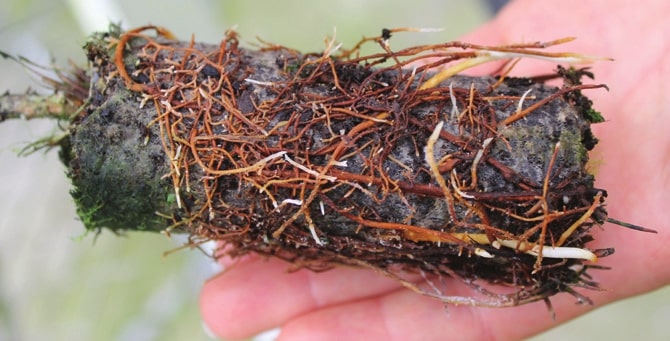
Stocktaking and quality
The years have slipped by and it is time to do some preharvest planning. Once again, remote sensing offers a way to rapidly assess your forest. Aerial laser scanning can be used to build up a detailed digital map of the land under the trees. With this, site access, skid site positioning and even tree extraction on steep sites can be optimised. Riparian, conservation or other areas that need special consideration, can also be identified and protected.
Laser scanning over and under the canopy can also be used to identify individual trees and provide an estimate of their volume, form and branching. Currently, researchers are able to detect stems with 97 per cent accuracy and provide a measure of diameter at breast height with nearly 90 per cent accuracy. This detailed data means it is possible to calculate accurately the value of your woodlot or forest block. There is also the potential to use the form and branching information to work out which logs are best suited for different applications and ensure they go to the appropriate processing, increasing your potential return.
Alongside increased productivity, other work is being carried out to improve wood quality. DiscBot uses direct and indirect measure to quantify a number of wood quality characteristics. Combining these with genetics, environment, management for individual trees will help untangle the link between these factors. This information will allow tree breeders to improve wood quality and provide guidelines on growing better quality wood in the future. Another benefit of increased knowledge around wood quality is that it will increase the confidence of wood processors in the resource coming on-stream.
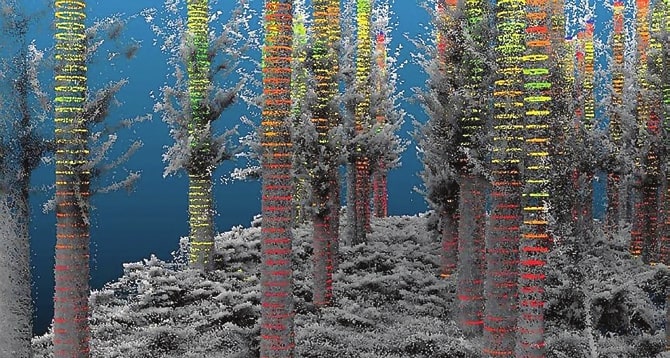
Planning further ahead
New Zealand’s existing and future forests will be more resilient and more productive, producing trees with desirable wood qualities as well as benefitting the environment and local communities. The research over the last seven years is having a real effect on forest productivity with recommendations which forests owners and managers can use now.
Improved forest nutrition, increasing use of remote sensing data, understanding and managing variation in wood properties and generating new research are just some of the results. In the near future, new growth and yield simulators which can model individual trees and include tree-to-tree interactions and with environmental interactions, will come into use.
Productive, sustainable plantation forests are essential for New Zealand’s future. As well as contributing billions to the economy, they will support the country’s move to a low carbon economy based on plants not fossil fuels. Take the bet that new rotations will be planned and grown quite differently compared to 2020 – it is a sure thing.
Funding
The Resilient Forests Programme started in October 2019. This programme is supported by funding from Forest Growers Research and the Strategic Science Investment Funding provided by MBIE. For more information contact peter.clinton@scionresearch.com.

 Farm Forestry New Zealand
Farm Forestry New Zealand

